





























•Lowest utility costs while using the least amount of energy and water

•Eliminates hazardous materials from textile cleaning
•Environmentally non-toxic and odor-free


•Customized Marketing & Technical Resources to fit your needs
Interested in finding out about an opportunity to join the GreenEarth Network in your market area? Scan the QR Code below or call us at 816-926-0895

Whether it is time to replace aging equipment or add new machines to take advantage of market opportunities, asking the right questions can save a dry cleaner time, money and headaches down the road.

14 22

Leaders must be able to tell when an employee is having di iculties that can be resolved, and when work ethic or character defects mean the company should part ways with that employee. Being prepared for both cases helps everyone involved.
8 © Copyright
Is It for Capital Improvements? Deciding steps for




Change, as the old saying goes, is the only constant in life. The methods that brought you success might not be the same ones that allow you to keep it in the future.
In this issue of American Drycleaner, we examine three areas of business that you need to be aware could — and in some cases, should — change over the course of your career.
Our first feature this month, “Is It Time for Capital Improvements,” asks the questions dry cleaners should have for their manufacturer or supplier when getting new or updated equipment. Often, it makes sense to repair a machine, but sometimes it’s time to invest in new equipment. No matter how well-built a piece of equipment is, there will come a day when it’s time for something new, and it’s important to get all the information necessary to make the right decisions.
Our second feature, “Dealing with Troublesome Employees,” explores how leaders can determine when they can help team members who are having temporary difficulties or are otherwise underperforming, and when it’s time to part ways with those whose work ethic or behavior could prove detrimental to the rest of the company. Sometimes, good employees go through a bad time, and sometimes its best to replace someone who doesn’t need to be working at your company.
Our final feature this month, “How Dry Cleaners Can Connect with Gen Z,” examines the ways, in the future, this young generation will be the dominant economic power group. And that future is rapidly approaching. While this group is young now — ranging at the moment from just entering high school to just entering the workforce — cleaners who take steps to communicate to this group in the ways that most resonate with them will have a decided advantage.
While change can be uncomfortable in the short run, it’s essential for long-term success. Take a look around to make sure you’re ahead of the changing curve.
American Drycleaner (ISSN 0002-8258) is published monthly except Nov/Dec combined. Subscription prices, payment in advance: U.S., 1 year $50.00; 2 years $100.00. Single copies $10.00 for U.S. Published by American Trade Magazines LLC, 650 West Lake Street, Suite 320, Chicago, IL 60661. Periodicals postage paid at Chicago, IL and at additional mailing offices.
POSTMASTER, Send changes of address and form 3579 to American Drycleaner, Subscription Dept., 125 Schelter Rd., #350, Lincolnshire, IL 60069-3666. Volume 90, number 7. Editorial, executive and advertising offices are at 650 West Lake Street, Suite 320, Chicago, IL 60661. Charles Thompson, President and Publisher. American Drycleaner is distributed selectively to: qualified dry cleaning plants and distributors in the United States. The publisher reserves the right to reject any advertising for any reason.
© Copyright AMERICAN TRADE MAGAZINES LLC, 2023. Printed in U.S.A. No part of this publication may be transmitted or reproduced in any form, electronic or mechanical, without written permission from the publisher or his representative. American Drycleaner does not endorse, recommend or guarantee any article, product, service or information found within. Opinions expressed are those of the writers and do not necessarily reflect the views of American Drycleaner or its staff. While precautions have been taken to ensure the accuracy of the magazine’s contents at time of publication, neither the editors, publishers nor its agents can accept responsibility for damages or injury which may arise therefrom.
President Charles Thompson Publisher
Donald Feinstein
312-361-1682
dfeinstein@ATMags.com
Editorial Director
Bruce Beggs 312-361-1683

bbeggs@ATMags.com
Editor
Dave Davis
312-361-1685
ddavis@ATMags.com
Digital Media Director

Nathan Frerichs
312-361-1681
nfrerichs@ATMags.com
Production Manager
Mathew Pawlak
Advisory Board
Jan Barlow
Mike Bleier
John-Claude Hallak
Monika Manter
Wesley Nelson
Kyle Nesbit
Fred Schwarzmann
Vic Williams
Wayne Wudyka
Contributing Editors
Dan Miller
Diana Vollmer
Martin Young
Office Information Main: 312-361-1700 www.american
ADC@Omeda.com

“Change before you have to.” – Jack Welch
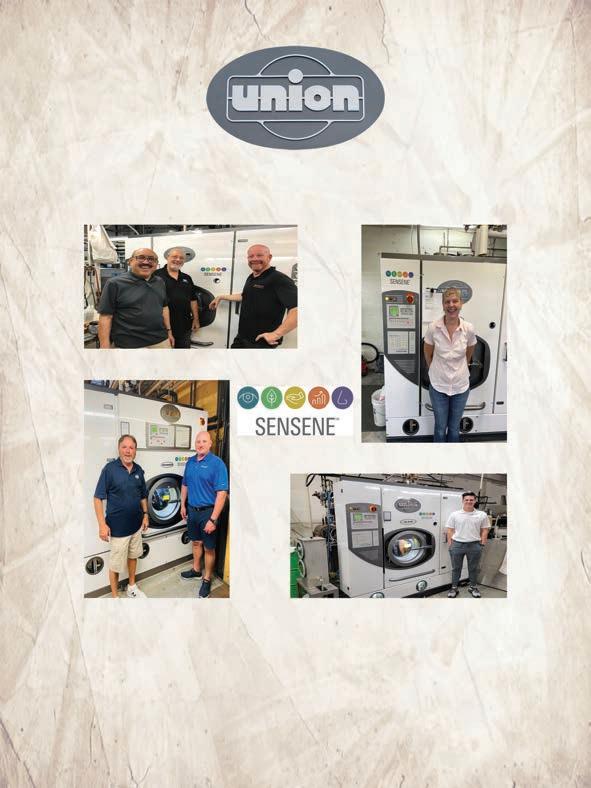

The environmental impact of dry cleaning has been long debated, and with the Environmental Protection Agency (EPA) discussing the eventual prohibition of the use of perchloroethylene (perc), many cleaners are examining their own practices. For this American Drycleaner “Your Views” survey, we asked or respondents about their actions and attitudes on this topic.
When we asked our audience if they advertised their business as “green,” “organic,” “environmentally friendly” or something similar, almost half (47%) reported that they did, while 35% responded “no,” and 15% said “no, but we’re considering it.”
The practice of wetcleaning is often seen as a more environmentally friendly practice in cleaning clothes, and, in our pool of respondents, 85% offer this as an option.
As for other strategies our respondents implement at their plants to lessen their environmental impact, 80% reported that they recycle hangers, poly and other materials, while 66% said they use alternative solvents, rather than perc. A little more than half (56%) use equipment designed to conserve energy and 35% offer reusable or biodegradable packaging. A further 9% said that they use alternative fuel or electric vehicles for delivery.
When asked why those who did market their company as “green” did so, answers included:

• People are searching for green alternatives, and it aligns with my personal beliefs.
• The larger point we try to convey to the customer is that dry cleaning is, in fact, far greener than processing your clothes at home or buying alternative fabrics that do not need to be professionally cleaned.
• We know our customers care about this, and we want them to know we share their sentiment and concern about protecting the world for future generations. And, for those who don’t market their company as “green,” answers as to why included:
• It’s a fad. Dry cleaners have always recycled. I’m proud of my business — I will not be shamed into thinking differently.
• It’s not popular in my area.
Do you advertise your business as “green,” “organic,” “environmentally friendly” or something similar?
Do you advertise your business as “green,” “organic,” “environmentally friendly” or something similar?
15% No, but we’re considering it 47% Yes 12% No
80%
Which of these strategies does your plant implement? (Choose all that apply)
Which of these strategies does your plant implement? (Choose all that apply)
66%
56% 35% 9%

Recycling
hangers, poly or other materials
Using an alternative solvent Using energyconserving equipment
Using an alternative solvent Using energyconserving equipment
Using alternative fuel/electric vehicles for delivery
Offering reusable/biodegradable packaging 1023 ADC Charts.indd 1 9/7/23 2:31 PM
about dry cleaning stopped coming in many years ago and are not going to come back because of a tag line.
• There is no standard for being “green,” We market our wet cleaning cleaning options. Customers who care about being green have found us that way..
• The general public has become desensitized to the terms “Green” and “Eco” — most don’t believe them. The people who have environmental concerns
The “Your Views” survey offers a current snapshot of the trade audience’s views. The publication invites qualified subscribers to American Drycleaner emails to participate anonymously in the unscientific poll each quarter.
































 By Dave Davis, Editor
By Dave Davis, Editor
No matter how good a piece of equipment is, sooner or later, it comes time to make a change. In a machinery-intensive industry like dry cleaning, owners understand that keeping track of their equipment’s performance is vital to minimizing downtime and serving customer needs.
The worst time to buy new equipment is when a machine breaks and causes a crisis. What should a dry cleaner be looking for to signal it might be time to replace their equipment before it’s an emergency, or add upgrades to take advantage of increasing opportunities?

TIME FOR SOMETHING NEW?




“Equipment age is a good starting place,” says Paulo Rocha, head of sales, HCS Business Unit for Miele Professional. “Drycleaning machines typically have a life span of 10 to 15 years. If you’re reaching the upper end of that spectrum, it’s like- ▼




























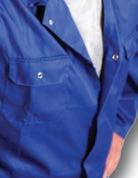

ly time to start preparing to invest in new equipment.”
Vic Williams, eastern sales manager for Union Dry Cleaning, agrees with this assessment.
“Is it worth the money to invest in a 15- or 20-yearold machine, or is it better to reinvest in a new piece of equipment? Do you really want to spend X amount of dollars to fix something when you don’t know if something else is going to break on it tomorrow?”
Besides the cost of repair, loss of productivity is also a factor.
“You have to weigh the cost that, if the machine goes down that day, how many days is it going to take to get the part and the labor to fix it,” Williams says. “Downtime is something to think about deciding when to replace equipment.”
“Another reason a lot of people change equipment, especially toward the end of the year, is to take advantage of tax benefits,” says Wesley Nelson, president of Sankosha USA. “If the cleaner is profitable in that year, their accountant might say, ‘You need to spend X amount of dollars to make the most of your tax benefits.’ If that’s the case, then look at what you can buy with that money to boost your business. Make that investment when you can.”
Other signs that it might be time for new equipment include frequent repairs of existing machines and decreased efficiency, says Rocha, “meaning higher energy consumption, longer processing times, and poorer product quality. All of these can be very disruptive to a dry cleaner’s profitability and overall operation.”
While their current machines might have gotten cleaners to where they are now, future success might require something new. Selecting machines that will meet today’s and tomorrow’s needs can be tricky.
“It’s important to stay informed of advancements in equipment technology that could disrupt the way dry cleaners operate,” Rocha says. “Operators should be looking at laundry equipment that is built with technological advancements in mind. Machines that offer longevity and programmability, for example.”
In addition to technology advancements, cleaners should also take their own advancement plans into account.
“If you ever want to grow the business, don’t buy a machine that’s too small,” Williams says. “You don’t want
something that fits you perfectly right now. What if the competitor down the street goes out of business? What if you grow the business by taking on routes? Where do you want to be in five years with your business? Do you want to do what you’re doing now, or do you want to grow? You always need to think about the future, and get something that’s adaptable for that future.”
“The business owners and operators who are informed and flexible — meaning they are willing to try new things and explore new ways of conducting business — will win long-term,” Rocha says.
Time goes by quickly in a fast-paced business, and it’s easy to lose track if you’re not keeping good records. Dry cleaners should take into account both the years and the mileage on their equipment when something breaks down.
“Estimated repairs over that time is key,” Williams says. “Often, the cost of the parts would be a good down payment on a new machine, and that’s not even considering the freight and the labor needed to get it back up and running.”
“We encourage our customers to take a long-term view of their equipment investments and calculate the total cost of machine ownership over time versus focusing solely on saving budget right now,” Rocha says. “With the right data, the decision to purchase — or not — becomes much easier.”
With any piece of machinery, Nelson says, wear and tear will start to take a toll. Keeping good records will allow a cleaner to better determine if a machine just needs a routine repair or if it’s time to consider retiring it.

“If you look at your records over time, you can see how much money per year or per month is being spent on a particular piece of equipment just to keep it up and running,” he says. “Often, it comes down to a major component on a piece of machinery. If it fails, you then have to balance the possible high cost of that component versus the benefits of buying a new piece of machinery. Sometimes it’s as simple as that.”
The numbers don’t lie, Nelson says: “When the curve starts to point up, then it’s probably a great time to get a new piece of machinery.”
When making a major purchase, dry cleaners need to ask the supplier or manufacturer any questions they
“I tried most of the other brands and none can match the simplicity and reliability of the Realstar Dry Cleaning Machines. After running our rst Realstar for 15 years with very little trouble we purchased another one to add to the capacity. ere was never a question on which one we would purchase. e reliability, the simplicity, and mostly the support when there was an issue were all the reasons we needed to stick with Realstar. It’s incredible when you call support and provide your model number and problem, you feel like the tech on the phone is standing in front of the machine with you, immediately you know you are in good hands. I’ve been doing this for 40 years now and have encountered a lot of vendors but none that I would write a testimonial on, until now. Keep up the great work you guys.”
 — Ben Combs, owner of Judi’s Cleaners Citrus Heights, California
— Ben Combs, owner of Judi’s Cleaners Citrus Heights, California
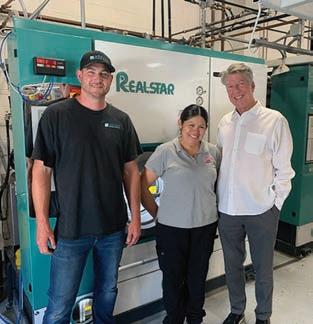 Jared Abram, owner of Abram Laundry Services, Antonia Mazatzi, Production Leader and 17 year employee of Judi’s Cleaners, and Ben Combs, owner of Judi’s Cleaners.
Jared Abram, owner of Abram Laundry Services, Antonia Mazatzi, Production Leader and 17 year employee of Judi’s Cleaners, and Ben Combs, owner of Judi’s Cleaners.
think they need answered to make the best decision for their individual situation.
“When we’re talking to a customer, we want to make sure they’re buying exactly what they need,” Nelson says. “Sometimes they don’t know what they need, but asking some simple questions can help. ‘What are your production numbers on a daily or weekly basis for a certain garment? What kind of garments are you planning to use this machine on? What machine are you currently finishing these garments?’ Just asking those kinds of questions can make sure that what they’re purchasing meets with their expectations.”
“It’s also helpful to ask about the total cost of ownership of the machine,” Rocha says. “This includes things like purchase price, installation, maintenance, and energy costs across the life of the machine.”
And then, there are nuts-and-bolt questions that need to be asked so the cleaner doesn’t get a nasty surprise on delivery day.
“Get the specs of the machine and make sure it’s going to fit in the space in the building,” Williams says. “You may be replacing the same model, but something might have changed. Maybe the machine’s a little taller now and they’ve just barely made it through before. When the machine arrives, you don’t want to see that it’s two inches too tall and you can’t get it through the doorway.”
“From a manufacturer’s point of view, you want to make sure the customer has the right utilities in place,” Nelson says. “Do they have the electric supply on hand that they need? Those are questions that need to be answered. Is this machine 110 (volt)? Or 220? How many amps does it need? Knowing these answers, you’re not scrambling around when the machine shows up, and we get a much happier customer.”
When replacing older machines or adding to the company’s inventory, new equipment can often lead to new profit potential. By working with the manufacturer or supplier, cleaners can make the most of this benefit.
“As a manufacturer, we should be able to tell them what items we can clean, and what new items we can clean,” Williams says. “Maybe they were using a solvent that really couldn’t clean certain items. By us helping them out that way, they may be able to get into another market of cleaning things they never cleaned before.”
This added capability is something that the cleaner can promote to customers to keep current clients happy and attract new business.
“Perhaps they can tell their customers that now they can clean leather, for example,” Williams says. “I’ve seen a lot of cleaners have to turn down leather work because they couldn’t do it.”
This expansion into new areas is made easier if cleaners are coached on how best to use their new tools.

“Purchasing new equipment is a significant investment,” Rocha says, “so it’s important to partner with a manufacturer that is going to take time to understand your needs and will offer hands-on training to ensure you get the maximum performance out of your machine to achieve your desired results.”
When making a big change in the equipment essential for the operation of the business, there will often be hidden costs associated with getting it up and running. Nelson believes that planning ahead can lessen the impact.
“A lot of times, the dry cleaners should try to coordinate delivery and installation when it’s convenient for them, and not worry so much about if it’s convenient for the manufacturer,” he says. “They should really do it based on their schedule and their timetable. Consider a long weekend like Labor Day, for example. Everybody wants to take off and relax, but sometimes that’s a great time to install equipment because it doesn’t upset your production.”
Organization is key for a smooth install, Nelson says: “The cleaner can also ask how much time it is going to take, and then make plans accordingly. The more prepared you are, the less urgency comes into play.”
Another thing is to consider how this new equipment could impact the cleaner’s workflow.
“If you’re doing shirts, for instance,” Williams says, “asking questions like, ‘Before, I had the X brand model and now I’m going to have your model. Is the washing the same or is it different?’ And if it is different, then you need to get your soap or chemical company involved to come and help reprogram your machines. If you’re proactive about all that, while people are there to train you, you’re not also messing around with adjusting the washing machine.”
(Continued on page 26)






In a perfect world, every employee would become a team member, creating a positive atmosphere and pulling together to bring themselves and the company success.
But in the world we live in, that’s not always the case. Sooner or later, an owner or manager is going to have to have a difficult discussion with an employee — one that will either turn that person’s performance around or be the last discussion they have as a company employee.
How leaders navigate this challenging experience will set an example for other employees, telling them either the company’s leadership is serious about productivity and developing a positive atmosphere for their teams, or that bad behavior will be tolerated in order to avoid unpleasant interactions with management.

Why is it important for leaders to get ahead of behavior or work ethic deficits?

“Bad attitudes are contagious,” says Amy Wischmann, policies and procedures manager at Benzinger’s Clothing Care, located in western New York state. “When people come to work with positive attitudes, those are equally contagious, but when you have someone who doesn’t have the right attitude — it could be their work ethic, or they might just have a lot of negativity — that can really poison the well.”
The example sets the tone for the workplace and can lead to difficulties for the entire team, says Sean Abbas, president of Threads Inc., a software company he co-founded to help organizations review employees and manage performance.



“You’re allowing somebody who’s not doing what they’re supposed to do to be around people who are doing
(Continued on page 19)


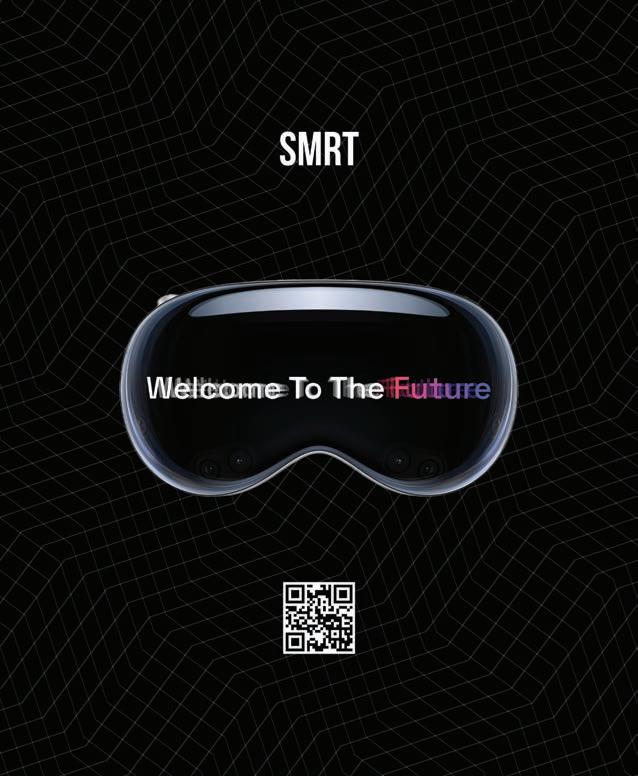

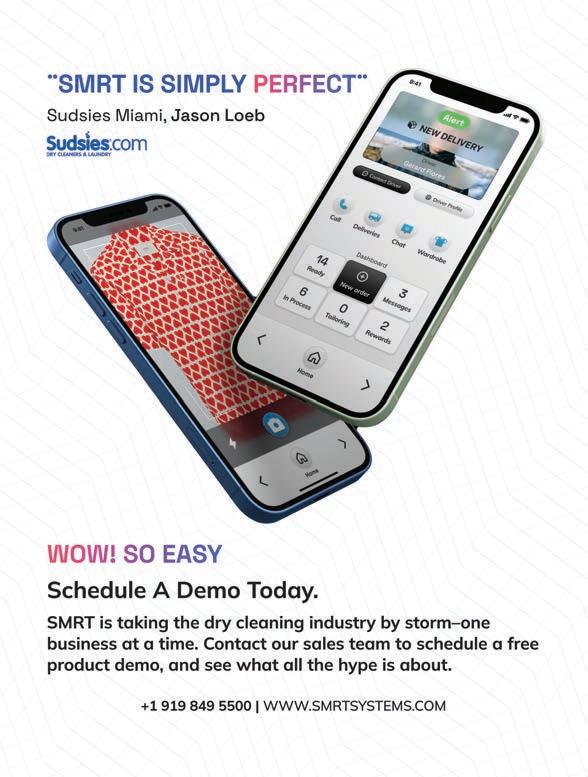

what they’re supposed to do, and you’re paying them the same amount of money,” he says, “And you’re hoping that somehow this thing is just going to rectify itself.”
This disparity can become a feedback loop, Abbas says, to the detriment of the company.
“If you’re replacing the employee doing things right and still have the employee who hasn’t been doing what you want, you’ve got real problems.”
While some leaders might not be comfortable in correcting — or confronting — unproductive or troublesome employees, they ignore the impact those workers have at their own peril.
“Leaders have to be on guard for two reasons,” Wischmann says. “They need to watch so it doesn’t lead to a loss of productivity. Perhaps more importantly, they need to be on the lookout for bad behavior that might cross the line into harassment, creating an uncomfortable work environment for other team members.”
Some leaders will avoid dealing with a troublesome employee and instead listen to the complaints of those around them, Abbas says: “A little bit of discomfort from 10 people seems to be more tolerable than a lot of discomfort from the one person.”
Abbas has found that this impulse isn’t rare — he’s found it in many companies he’s visited over the years.
“I’ve walked into businesses, and they’ll tell me, ‘We’ve got a real culture problem here,’” he says. “And the reality is, after spending about an hour there from the outside looking in, they’ve got one person who’s an absolute ass. I’ll ask them if they realize that, and they’ll say, ‘Yeah, but that’s just the way they are,’ and tell me how their skills and abilities are so valuable. What that owner actually has isn’t a culture problem but a leadership problem, because they’re unwilling to deal with the problems of one or two people.”
Abbas recalls a former employee of his who, while excellent at his job, was a nightmare to those around him — so much so that his department had a rash of people quit.
“We were having trouble hiring enough people to deal with the turnover,” he says. “We finally got to the place where we told the individual causing this problem that he needed to change the way he was doing things. The person got upset and just quit and left — and that was the beginning of fixing the problem long-term.”
While that employee took his skills and institutional knowledge with him, the turnover issue quickly evaporated.
“If you feel like you can’t replace them, you’re going
to deal with the byproducts of what they do inside your organization,” Abbas says. “Those people around them are also talented, and they might be great leaders in the future.”
Wischmann has found that avoiding employee issues starts at the very beginning.
“I’m a big believer in not letting (issues) happen in the first place,” she says. “That means, at the outset, having a really good onboarding process, where the employee is told the expectations for our workplace. ‘These are our values. This is our mission. We’re customer-centric, and we care for one another.’ That sets the stage right out of the gate, and we have them sign off on that.”
Setting company expectations from the beginning requires leaders to have clear and open communication with the new hire.
“Employers need to have those performance conversations immediately,” Wischmann says. “Go over their job description with them. Encourage them to ask questions along the way, and encourage their manager supervisor to develop a relationship with them from day one. Two-way conversation very early on in the relationship is important.”
Abbas has found that an employee handbook is a valuable tool for effective onboarding.
“It establishes the boundaries of the relationship,” he says. “I’m not a huge fan of a 50-page employee handbook — I think you need to have something that’s very modest. And if you’re a small company, there are a lot of resources out there to develop a handbook.”
One of these resources can be the state Labor Department.
“Most states will have guidelines,” Wischmann says. “In New York, the state Department of Labor will look through your employee handbook for you and give you suggestions for free. Ask your state Labor Department if they can provide you with a template, or to review your handbook and ask if anything is missing.”
“LEADERS HAVE TO BE ON GUARD FOR TWO REASONS,” WISCHMANN SAYS. “THEY NEED TO WATCH SO IT DOESN’T LEAD TO A LOSS OF PRODUCTIVITY. PERHAPS MORE IMPORTANTLY, THEY NEED TO BE ON THE LOOKOUT FOR BAD BEHAVIOR THAT MIGHT CROSS THE LINE INTO HARASSMENT, CREATING AN UNCOMFORTABLE WORK ENVIRONMENT FOR OTHER TEAM MEMBERS.”
The best employee can have an off day, and stresses such as family illness or other issues can have an impact on performance. Leaders need to know when this is the case, rather than a lack of work ethic or other behavioral issue at play.

“If it’s somebody who’s done a great job for a long time, and they’re having some personal issues and are a bit off the rails, the first thing I would tell them is how important they are to the organization and that we need them back,” Abbas says. “You can ask them if there’s something that you can do to help or support.”
In order to determine if it’s a temporary lapse or a deeper issue, Wischmann believes that it’s vital that the employee’s supervisor understands them on a personal level.
“From day one, whoever is going to be responsible for that employee has to start getting to know them,” she says. “You aren’t going to know if someone’s going through a rough time unless you know and care about them. It doesn’t take a lot of time — 5- to 10-minute check-ins with them regularly — to get to know them and get a feel for their personalities.”
This process allows leaders to get to the bottom of an issue more quickly, which is a positive for everyone involved.
“If Sally was cheerful and helpful when she started working here, and now she’s calling off work a lot, have the conversation,” Wischmann says. “If she’s comfortable with you, she’ll let you know she’s having difficulties at home. If you take the time to develop that kind of relationship with employees, they’ll reward you for that.”
But if the problem isn’t a momentary lapse, Wischmann
believes the quicker leaders get involved, the better.
“You have to call that kind of behavior out immediately,” she says. “There might be uncomfortable situations, but the quicker you nip that in the bud, the better. It’s a simple conversation — ‘That behavior is unacceptable here.’”
When dealing with inappropriate behavior or productivity issues, both Abbas and Wischmann stress how important it is for supervisors to document their interactions with employees.
“Make sure you are documenting everything, even if you just have a conversation with an employee,” Wischmann says. “One of the best things that a supervisor or manager can do is just take five minutes afterwards to type up how that conversation went. Later, check back in with that employee and let them know that’s how you recalled the conversation. Ask them if that’s their recollection, as well, and have them sign off and acknowledge it. It doesn’t have to be time-consuming.”
This step is important, she says, both to provide clear instructions to the employee and to provide a paper trail if termination is the ultimate result.
“The only protection as an employer you’re going to have is if you can open to your personnel files or your computer files and say, ‘Yes, here are three different times that we documented speaking to this employee prior to terminating them,’” she says.
Abbas adds that capturing conversations in the moment can provide a leader with a clearer picture of the relationship, rather than risking those talks being lost in time.
“Supervisors and managers can forget about 10 things because they wrote nothing down,” he says. “Remember — you’re about to walk into the owner’s office or to the HR office to say, ‘Look, I’ve had it with this person. They’ve been late numerous times.’ The first thing they’re going to ask you is, ‘Have you documented anything?’”
Being able to pull up notes allows everyone to be on the same page, says Abbas: “You have to understand that you’re 10 steps down the road, but HR is really starting from step one. If you haven’t written anything down, there’s not really much that can be done formally about it. But if you walk in with a list, then you can go to that written warning.”
When the decision is made to terminate an employee’s time at a company, Abbas believes the final call should come as no surprise to anyone.
“If we’re going to get to the place where we’re going to part company, I’m never going to just blindside them,” he
(Continued on page 27)
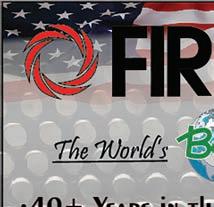
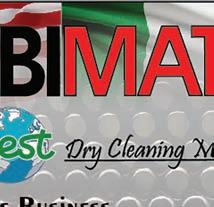

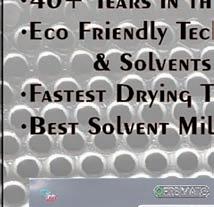
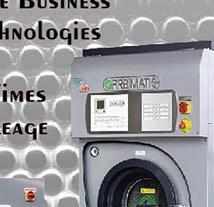

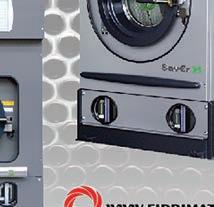


 By Dave Davis, Editor
By Dave Davis, Editor
To build for the future, dry cleaners need to capture the business of younger customers in order to become their cleaner. Failing to consider what makes the next generation tick, however, can lead to diminished returns and lower retention rates.

This was the message of Lorynn Divita, Ph.D., during her online workshop, “Connecting with Gen Z — The ‘Values’ Generation,” sponsored by the National Cleaners Association (NCA). Divita, an associate professor in apparel design and merchandising at Baylor University since 2002, has seen her classes shift from millennials when she began her career into Gen Z.
From this vantage point, Divita has found a definite evolution in the attitudes, behaviors and motivations between Gen Z and their older counterparts. And, she adds, dry cleaners who understand this change — and act accordingly — can reap the rewards.
“I’ve been teaching them for several years, and they really are different,” she says, “and different isn’t bad, but you do need to be aware of it so that you can really be prepared for it.”
While there is only one generation that is statistically defined by the U.S. Census Bureau — the baby boomers, born between 1946 and 1964 — Gen Z is generally regarded as those born between 1997 and 2012. While the younger half of that contingent is currently in middle or high school, the older half are close to graduating college or are currently in the workforce.


And, while they are young, they are going to be a force to contend with for dry cleaners.
“Gen Z is an awfully powerful group,” Divita says. “They are approximately 25% of the world’s population with a massive purchasing power, and they will be the largest U.S. consumer group within 10 years.”
While they will rival the majority spot boomers once occupied in numbers, Gen Z is facing economic challenges the older generation didn’t.

“They are estimated to have 86% less purchasing power than the baby boomers did in their 20s because of things like inflation, rising home costs, student debt, stagnant wages, and so on,” Divita says, “so they actually are not as secure financially as the boomers were at the same point in life. But they still will wield a great deal of power.”
Divita’s field is to study culture and fashion, she says, and apply that to the topic of fashion forecasting and fashion marketing. As such, she believes she can add valuable insight for industries such as dry cleaning.
“I consider dry cleaning an auxiliary industry to the fashion industry,” she told her audience. “Your industry sees fashion change by the different fibers and fabrications and silhouettes that come through your doors to be cared for. So, what happens in fashion absolutely impacts you.”
This is also true for the consumer who is bringing those items through the doors. These are the students currently in Divita’s classroom, if they are not coming into your store already.
They’re poised to be the next driving economic force, but who are they?





“What I can tell you is I have absolutely positively seen a shift over the last few years in how these young people think and how these young people act,” she says. “It’s not really ours to try to change or criticize, because frankly, we will lose that battle. But what we can do is recognize what’s happening and figure out how we can adjust.”
Divita says that Gen Z holds many viewpoints that set them apart from previous generations, and that’s in large part to being the first generation to be “digital natives.”
“Unlike myself, a digital immigrant, we have a whole generation of digital natives,” Divita says. “This group is not only not digitally native to computers, they’re also digitally native to mobile phones, which is huge. This means that they grew up with them in their hands.”
Another defining moment for Gen Z was the housing market recession in 2008, Divita believes, which shaped their worldview. “Some of them have a parent who was thrown out of work,” she says, “and they remember it. So, it has really impacted how they relate to other generations and to each other.”
One handle that has been put on this group of young people, and Divita believes it is accurate, is that they are the “We” generation, because they are more interconnected than other generations have been.
“They were raised with their mobile phones in their hands,” she says, “they skew politically progressive, and they’re also unbelievably pragmatic.”
This digital availability, Divita says, has changed how the younger generation views very basic things like interacting with others both physically around them and in society.
“Gen Z is very connected, and their ideas of connections are very different from mine,” she says. “If they’ve never met someone, but say ‘Oh, I follow them,’ that sort of counts as a relationship to them.”
Other areas that might have held more of a stigma to older generations are also more accepted by Gen Z.
“They’re very open about their mental health, for instance — both the medications they take the therapy they receive,” Divita says. “They’ve accepted the self-care that they need, and they’re open about it.”
Other areas where Gen Z differs from their elders are that they tend to be more politically active and engaged and are less likely to smoke and drink alcohol.
If a business owner such as a dry cleaner can connect with some of the key values that are important to Gen Z,
Divita says, that owner can build a relationship that will carry long-term rewards. So, what are some of these values?




Utility — “Do not waste their time,” Divita says. “They have absolutely no time for things that do not serve them or lack utility. But they what they see as being ‘useful’ is not necessarily what we would. If they enjoy something and it makes them laugh, or they want to share it with someone and say, ‘Hey, look at this,’ that is considered to be as useful as much as something that makes them money.”
Divita believes this urge for utility is one of a dry cleaner’s biggest strengths when it comes to connecting with Gen Z.
“Do cleaners provide utility? Absolutely,” she says. “Just by operating your business, you save consumers a lot of time. Whether you’re doing mainly laundering services or drycleaning services, you are saving them time.”
This utility also is fed by extending the life of their clothing.
“That means that they don’t have to go shopping as much,” Divita says. “You are fixing problems, you are taking out stains, you are repairing damaged merchandise, you are hemming things for them … you are doing things for them that they literally could not do themselves, and don’t necessarily want to take the time to do for themselves. So, you provide utility.”
Authenticity — “Gen Z reports that being true to their values and beliefs makes a person cool,” Divita says. “They do not care about everything looking picture perfect and in place. Gen Z really cares more about the substance and expressing their authentic inner lives.”
Divita believes that this desire for authenticity carries over to the brands that Gen Z wants to frequent. So, how can dry cleaners build this sense of authenticity?
“Talk about your integrity,” Divita says, “and separate values from attitudes. Every dry cleaner I have met talks about the dignity of work and how they are so happy that they provide jobs to people. These are jobs in a safe environment. They are jobs for people where they can be useful and apply their skills.”
And, the good news Divita feels is that selling this authenticity should be no problem for most dry cleaners — it’s just a matter of saying it out loud.
“I have never met a dry cleaner who doesn’t love their employees,” she says. “You provide them with a very good job, and that’s something to be proud of. I’ve also never met a dry cleaner who isn’t obsessed with providing their customers with quality service. Capitalize on that — you can make that your messaging.”
Social Consciousness — Gen Z is more likely to do
business with a company that not just talks about doing good in their community, but demonstrates it. This is another area where many dry cleaners shine. The key to connection, again, is simply letting people know what you are doing.
“How do you care about people rather than just profit?” Divita asks. “I’m sure you all donate to local school fundraisers. I’m sure you sponsor kids’ sports teams, or maybe you give your employees a day where you all go down and serve at the soup kitchen. Maybe you have coat drives or food drives. Whatever you do, make this known — let them know you do good things.”

For dry cleaners wanting to connect with Gen Z, they might have to provide education into exactly what it is they do, and why it’s important, Divita says.
“Gen Z is in desperate need of understanding how to care for their clothing,” she says. “They really are lacking in this basic skill. Gen Z did not grow up observing their mothers and grandmothers doing the laundry. This is information they are clamoring for.”
Divita points to a recent survey on the website talker. news, which found that 65% of millennials and Gen
Z believe laundry is a skill that needs to be taught or learned. The survey also found that 45% of these groups reported learning how to do laundry by parents or older relatives, 23% through experimentation, 19% from social media tutorials and 43% from YouTube videos.
“YouTube actually beats out parents and older relatives by 1%,” Divita says.



This is an avenue that dry cleaners can use to not only provide a valuable service, but set themselves up as the trusted professional that can get their jobs done.

“You could do tutorials,” Divita says, “or you could even post videos with different stains asking ‘Will it come out?’ You can make before-and-after videos of wrinkled shirts or sheets and how beautiful they are when they come out. Make videos of you taking out a stain. There is so much room for you to create content.”
The great thing about providing this service is that it is something dry cleaners can do immediately, using the phones in their pockets.
“Traditional barriers to having a platform are gone,” she says, “so if you’ve got a young person in your orbit — a kid or grandkid or even a young employee — ask them to make a video or post and see what happens. Anything is possible.”
To bring out a new piece of equipment’s full potential, the owner and the people who will operate it need all the information they can get, and the manufacturer or distributor should be willing to provide this knowledge.

“In general, most new equipment will require some sort of training so that operators fully understand how to use the machines,” Rocha says. “This training could be as simple as reviewing the general operation of the machine, or it could be something more specific, like reviewing the programmability and how to fine-tune to specific needs of the product or wash. This might take some time upfront but will allow operators to offer the best results for their customers.”
“If the startup is done precisely by the manufacturer or the distributor who sells the machine, that’s the key to make the machine run really well,” Williams says. “You go through the whole machine with the customer, and
when I say ‘customer,’ I mean the owner of the plant.”
He stresses that, while the owner might not be operating the machine, he or she needs to have a fundamental understanding of it.
“So many times, we’ve gone in and the owner will just say, ‘Train my guy,’” Williams says. “Well, that person leaves in six months, and nobody has a clue about the machine. If you’re the owner, you’re the one buying this piece of equipment, so please be attentive when someone comes to train.”
While this might mean the owner has to clear some time in his or her schedule, it is an investment in both the equipment and their company.
“A good startup can last anywhere from a few hours to a couple of days,” Williams says. “The manual is a good place to start, but a hands-on teaching session is better. Also, if they’ve devoted the time to be there with you and show you the machine, there’s no such thing as a stupid question. A good startup will eliminate 98% of the callbacks and problems that may occur over the phone.”

says. “I’m going to make sure that, if we’re at that place, when I walk out and say, ‘Hey, I need to visit with you in my office,’ they know it. We’ve talked about it. They know there’s a problem. We have documented the problems. We’ve spoken about the problems. I’ve asked if there’s anything we can do to help them resolve the issues.”
Abbas says that this clarity serves everyone in this unfortunate circumstance.
“I know they knew what was at stake,” he says. “And they’ve chosen not to do what I’ve asked them to do. In other words, when it gets to that point, the employee has chosen to not work for you anymore — you’re just simply opening the door and letting them walk out.”
For Wischmann, preparing for a termination meeting is just as important as preparing for any other meeting.




“We talk about onboarding new employees, but there’s also the process of offboarding that should be thought about,” she says. “Knowing in advance what to plan for is valuable. Are you going to pay them the rest of their sick days, PTO (paid time off) or vacation time? Also, think through what that employee might have that needs to be returned. Do they have keys to the building? Do
they have a computer?”
She also says that, during such a meeting, there should be a witness: “You want more than one person there, whether that’s your HR person, or the owner and the supervisor of the person. You want someone else in that meeting.”
Also, have a document that the employee can sign: “It can be very simple — just a little one-page form acknowledging that they understand that they were terminated. You don’t want to go into detail. You don’t need to give them a lot of reasons about why they are being let go. You want to keep that pretty concise.”
Perhaps most importantly, Abbas says, is to have clarity into why the person is being terminated from your company, and leave emotions out of it — both for the employee’s sake and your own.
“If you’re firing someone because of what they did, you’d better be firing them for exactly what they did,” he says. “You need to be communicating those things and leave the personal stuff out of it. It doesn’t serve any purpose. It’s not going to make you feel any better.
“This isn’t the movies — this is a person’s life. It’s their livelihood. You have to be able to live with yourself and how you’ve done what you’ve done, and how you communicated what you’ve communicated.”
NFIB study finds labor quality, costs continue to be top business problems
WASHINGTON — According to the August jobs report by the National Federation of Independent Business (NFIB), 40% (seasonally adjusted) of small business owners reported job openings they could not fill in the current period, down two points from July and the lowest level since February 2021. Seasonally adjusted, a net 36% of owners reported raising compensation in August, tying June’s reading, and marking the lowest reading since May 2021. A net 26% of owners plan to raise compensation in the next three months, up five points from July.
“More small-business owners are planning to increase compensation in the next three months as unfilled job openings slipped in August,” says Bill Dunkelberg, NFIB Chief Economist. “Even as openings fell on Main Street, owners are actively working to retain current employees and attract qualified applicants.”
The percent of owners reporting labor quality as their top business operating problem remains elevated at 24%. Labor costs being reported as the single most important problem to business owners decreased two points to 8%, five points below the highest reading of 13% reached in December 2021.
Small-business owners’ plans to fill open positions remain elevated, with a seasonally adjusted net 17% planning to create new jobs in the next months, unchanged from July but 15 points below its record high reading of 32 reached in August 2021.
Overall, 59% of owners reported hiring or trying to hire in August, down two points from July. Of those hiring or trying to hire, 92% of owners reported few or no qualified applicants for the positions they were trying to fill, down two points from July. The report found that 33% of owners reported few qualified applicants for their open positions and 21% reported none.
Thirty-five percent of small business owners have job openings for skilled workers and 18% have openings for unskilled labor.
When asked about the overall change in employment at their firm, 12.8% reported higher and 12.4% reported lower, a fairly flat performance. All industries reported fewer job openings compared to last month except for services (up one point) and professional services (up one point).
New hire brings three decades of experience and marketing leadership to role

SAVAGE, Md. — ZIPS Franchising LLC recently announced that Mary Ann Donaghy has joined the organization as chief marketing and customer experience officer. Previously a member of the ZIPS Board of Directors, she brings three decades of consumer marketing leadership to the organization as it continues to grow its revenues and expand its customer base and franchisees.
Donaghy also brings her experience of developing and implementing integrated marketing plans in a range of industries and has a passion for strengthening brands through an exceptional customer experience, the company states.
Donaghy
She joined the ZIPS Board of Directors a year ago while also operating Insights & Impact, a consultancy providing multiple services to clients in higher education, senior living, trade associations, real estate development and management, and government contracting.
ZIPS states that Donaghy is a data-driven marketing leader with a particular focus on consumer insights and business analytics to drive brand building and business development, which has contributed to significant quantitative results in her marketing leadership roles. Her expertise in this area will be of critical importance to ZIPS, the company says, as the brand continues to adapt to the changing work habits and apparel choices of an evolving population.
“Mary Ann brings an incredible marketing background and proven leadership to the organization as we focus on these key areas to fuel our success in the years ahead,
and we are thrilled to add her vast experience in marketing as well as her perspective as a former Board member to our team,” says Bob Barry, ZIPS’ president and CEO.
“From my time serving on the Board, I saw the contribution I could make to elevating the ZIPS’ marketing and customer experience efforts. I have a deep enthusiasm for the brand and the company and am thrilled to be joining ZIPS at such a pivotal time,” Donaghy says.

Former president of company will continue to oversee its network of affiliates
KANSAS CITY, Mo. — GreenEarth® Cleaning, a company focused on environmentally friendly dry cleaning and providing non-toxic cleaning alternatives, recently named Tim Maxwell as its chief executive officer (CEO). Maxwell had served as president of the company since 2003.
In his role as CEO, Maxwell will continue oversight of GreenEarth Cleaning and the company’s network of Affiliates. GreenEarth’s proprietary products and processes
are available at more than 6,000 points of consumer contact around the globe.

“What has been most gratifying to me over the past 20 + years has been the commitment by so many members of both the Affiliate network, and the staff at GreenEarth to innovate the system to not only reduce energy and additive usage, but provide the lowest overall operational cost to garment care providers,” says Maxwell.
Expansion of the company’s Affiliate Network has been deliberate and measured over the past 24 years, Maxwell says, and has provided the company with sustainable growth during that time
“We are proud to include some of the finest garment care providers in the world among our Membership,” he says, “whether that be a 7-Star hotel in Dubai, the holder of the Royal Warrant in England, or a family-run counter in Minneapolis.”
Added Maxwell, “Providing a kinder clean in even more markets in the coming years is a ‘challenge accepted’ for the GreenEarth Team.”
•Presses and Solutions for all Budgets
•Best and Free Technical Support Forever
•Proudly Made in the USA
•We are the Only Manufacturer of TÜV SÜD Safety Certified Presses; Includes OSHA and UL Safety Standards


•Low Cost of Ownership – Very Reliable, Easy to Fix and Upgradeable
•Pre-printed Sequentially Numbered Heat Seal Barcode Labels in One Day
2023 RATES: One- to five-time rate: $2.35 per word, boldface $2.40 per word. Minimum charge: $50.00 per ad. Call or write for our threeand 11-time rates. If box number is
used, add cost of 5 words. Display classified rates are available on request. All major credit cards are accepted.
DEADLINE: Ads must be received by
Paying
the 1st of the preceding month. For example, for a August ad, the closing date is July 1st.
PAYMENT FOR CLASSIFIED ADS: Must accompany order.
Call
— •
•
•
•
•
Contact
Publisher, Editor, and Managing Editor. Publisher: Donald Feinstein, American Trade Magazines LLC, 650 West Lake St., Suite 320, Chicago, IL 60661-1036 Cook County. Editor: Dave Davis, American Trade Magazines LLC, 650 West Lake St., Suite 320, Chicago, IL 60661-1036 Cook County. Managing Editor: Bruce Beggs, American Trade Magazines LLC, 650 West Lake St., Suite 320, Chicago, IL 60661-1036 Cook County. 10. Owner: American Trade Magazines LLC, 650 West Lake St., Suite 320, Chicago, IL 60661-1036 Cook County. Charles Thompson, American Trade Magazines LLC, 650 West Lake St., Suite 320, Chicago, IL 606611036 Cook County. Donald Feinstein, American Trade Magazines LLC, 650 West Lake St., Suite 320, Chicago, IL 60661-1036 Cook County. Bruce Beggs, American Trade Magazines LLC, 650 West Lake St., Suite 320, Chicago, IL 60661-1036 Cook County. Nathan Frerichs, American Trade Magazines LLC, 650 West Lake St., Suite 320, Chicago, IL 60661-1036 Cook County. John S Suhler, 200 Long Neck Point Rd., Darien, CT 06820 Fairfield County. 13. Publication
Title: AMERICAN DRYCLEANER 14. Issue Date for Circulation Data
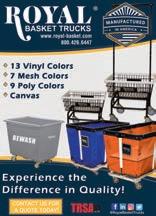
Below: September 2023 15. Extent and Nature of circulation: (average number of copies each issue during proceeding 12 months = “X”) (Number copies of single issue published nearest to filing date = “Y”) (a)Total Number of Copies (Net press run): X=10,495, Y=10,214. b. Legitimate Paid and/or Requested Distribution (By Mail and Outside the Mail). (1) Outside County Paid/Requested Mail Subscriptions stated on PS Form 3541. (Include direct written request from recipient, telemarketing and Internet requests from recipient, paid subscriptions including nominal rate subscriptions, employer requests, advertiser’s proof copies, and exchange copies.) X=6,267, Y=5,964. (2) In-County Paid/Requested Mail Subscriptions stated on PS Form 3541. (Include direct written request from recipient, telemarketing and Internet requests from recipient, paid subscriptions including nominal rate subscriptions, employer requests, advertiser’s proof copies, and exchange copies.) X=0, Y=0. (3) Sales Through Dealers and Carriers, Street Vendors, Counter Sales, and Other Paid or Requested Distribution Outside USPS®: X=0, Y=0. (4) Requested Copies Distributed by Other Mail Classes Through the USPS (e.g. First-Class Mail ®): X=0, Y=0. (c) Total Paid and/or Requested Circulation (Sum of 15b (1), (2), (3), and (4)): X=6,267, Y=5,964. (d) Nonrequested Distribution (By Mail and Outside the Mail). (1)Outside County Nonrequested Copies Stated on PS Form 3541 (include Sample copies, Requests Over 3 years old, Requests induced by a Premium, Bulk Sales and Requests including Association Requests, Names obtained from Business Directories, Lists, and other sources): X=3,728, Y=3,750. (2) In-County Nonrequested Copies Stated on PS Form 3541 (include Sample copies, Requests Over 3 years old, Requests induced by a Premium, Bulk Sales and Requests including Association Requests, Names obtained from Business
(i) Percent Paid and/or Requested Circulation (15c divided by f times 100): X=62.70%, Y=61.40%. 16. Electronic Copy Circulation: (a) Requested and Paid Electronic Copies: X=364, Y=363 (b) Total Requested and Paid Print Copies (Line 15c) + Requested/ Paid Electronic Copies (Line 16a): X=6,631, Y=6,327. (c) Total Requested Copy Distribution (Line 15f) + Requested/Paid Electronic Copies (Line 16a): X=10,358, Y=10,077. (d) Percent Paid and/or Requested Circulation (Both Print & Electronic Copies) (16b divided by 16c x 100): X=64.01%, Y=62.79%. I certify that 50% of all my distributed copies (electronic and print) are legitimate requests or paid copies. 17. Publication of Statement of Ownership for a Requester Publication is required and will be printed in the October 2023 issue of this publication. 18. Signature and Title of Editor, Publisher, Business Manager, or Owner: I certify that all information furnished on this form is true and complete. I understand that anyone who furnishes false or misleading information on this form or who omits material or information requested on the form may be subject to criminal sanctions (including fines and imprisonment) and/or civil sanctions (including civil penalties): Donald Feinstein, Publisher, Date 9/15/2023.





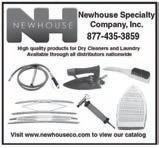
10 YEARS AGO. Signs are Looking Up — The July 2013 Surveys of Consumers reported consumer confidence was at its highest level in six years. The report, from Thomson Reuters and the University of Michigan, showed a third month of increasing confidence at higher levels since July 2007. “The July survey suggests a growing resilience among consumers,” said Richard Curtin, the Survey’s chief economist, “that will enable them to more easily withstand the cross-current inevitable in a slow-growth economy.”
25 YEARS AGO. Handle with Caution — The EPA’s recently released “Cleaner Technologies Substitutes Assessment for Professional Fabricare Processes” (CTSA) was created to be a helpful guide for various decision makers, but critics said that much of the information was false or misleading, and could cause more harm than good for the industry. Three years in the making, an American Drycleaner editor advised readers to “use it for what it’s worth. Don’t rely on secondhand versions, such as proposed by EPA because the original document is so complex it’s ‘not intended’ for small cleaners but should only be used by ‘technically informed decisions makers.’” The editorial went on to ask, “If the source document is not reliable, how can the summary from EPA or any spinoffs be trusted?”
50 YEARS AGO. Cashmere’s Comeback — The cashmere sweater of the 1940s and 1950s was expected to make a comeback in the mid1970s, reported the International Fabricare Institute (IFI). The IFI noted that there was a whole generation of young adults who had never known or owned a cashmere sweater. This luxury fiber that required drycleaning was expected to be big in the fall of 1973. The return of the cashmere sweater, the IFI reported, was in keeping with the strong classic and casual sportswear trend in dressing that was popular with young adults of the time.

75 YEARS AGO. Looking for the One Dow Chemical Co.’s contest to find the nation’s outstanding counter girl was bringing in responses from all over the United States. The winner of “Miss Counter Girl” would be selected for her arrangement of the 18 important characteristics listed on the entry form, and for her prizewinning essay about one of those characteristics. The winner of the contest would receive a large trophy, presented at a plant banquet in the winner’s town, and would be presented to her own state convention and other cleaners’ meetings.
— Compiled by Dave Davis, Editor
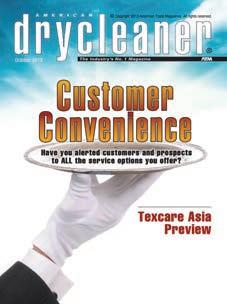











When you welcome American Express® Cards, you have access to benefits, services and programs to help your business thrive, including curated o ers and discounts to help you get more out of your business, and solutions and tips to help attract new customers. Scan the QR code for more information on available resources.










